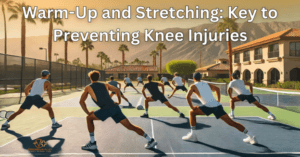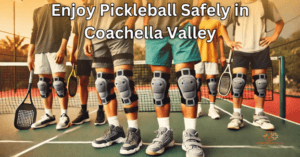Pickleball has quickly become a beloved pastime in Coachella Valley, offering a unique blend of tennis, badminton, and ping-pong that provides a fun and engaging way to stay active and socialize. However, like any sport, pickleball comes with its own set of risks, particularly when it comes to pickleball knee injuries. The quick movements and sudden changes in direction that characterize the game can put significant stress on the knees, potentially leading to strains, sprains, and more severe injuries like meniscus tears. Understanding these risks and knowing how to prevent them can help you enjoy pickleball safely and keep you on the court for years to come.
Understanding Pickleball Knee Injuries: Risks and Prevention
The knee is a complex joint made up of bones, cartilage, ligaments, and tendons. It’s designed to support our weight and allow for a wide range of motion, but it can be vulnerable to injury, particularly in high-impact sports like pickleball.
Common Knee Injuries in Pickleball Players
- Strains and Sprains: These occur when muscles or ligaments around the knee are stretched or torn due to sudden, forceful movements. A strain affects muscles or tendons, while a sprain involves ligaments.
- Meniscus Tears: The meniscus is a C-shaped piece of cartilage that acts as a cushion between your thigh bone and shinbone. Quick pivots and twists during pickleball can cause tears in the meniscus, leading to pain, swelling, and difficulty moving the knee.
- Patellar Tendonitis: Also known as jumper’s knee, this condition involves inflammation of the tendon connecting the kneecap to the shinbone. It is often caused by repetitive stress and overuse.
- ACL Injuries: The anterior cruciate ligament (ACL) is crucial for stabilizing the knee. ACL injuries, which can range from minor strains to complete tears, are usually caused by sudden stops or changes in direction, which are common in pickleball.
Essential Tips for Preventing Knee Injuries in Pickleball
Preventing knee injuries in pickleball involves a combination of proper technique, appropriate gear, and maintaining overall fitness. Here are some tips to help you stay safe:

Warm-Up and Stretching: Key to Preventing Knee Injuries
Always begin your pickleball session with a thorough warm-up. Spend at least 10-15 minutes doing light cardio, such as brisk walking or jogging, followed by dynamic stretches that target the lower body. This helps increase blood flow to the muscles and prepares your body for the physical demands of the game.
Strength Training to Protect Your Knees in Pickleball
Incorporate strength training into your regular fitness routine to build the muscles around your knees. Strong quadriceps, hamstrings, and calf muscles provide better support and stability for your knees. Exercises such as squats, lunges, leg presses, and calf raises can be particularly beneficial.
Choosing Proper Footwear to Avoid Pickleball Knee Injuries
Wearing the right shoes is crucial. Choose footwear designed for court sports, which provides good support and cushioning and allows for quick lateral movements. Avoid running shoes, as they are not designed for the side-to-side movements typical in pickleball and can increase the risk of injury.
Good Technique to Minimize Knee Injury Risk in Pickleball
Proper technique not only improves your game but also reduces the risk of injury. Focus on using your whole body for power rather than just your knees. Bend your knees and use your legs and core to absorb the impact of your movements. Consider taking lessons or watching tutorials to ensure you are playing with the correct form.
Listen to Your Body: Early Signs of Knee Injuries
Pay attention to any signs of discomfort or pain in your knees. If you experience pain, swelling, or stiffness, take a break and rest. Continuing to play through pain can lead to more severe injuries. Applying ice, compression, and elevation can help manage minor strains and sprains.
Immediate Steps to Take If You Suffer a Knee Injury
Despite taking precautions, injuries can still happen. If you experience a knee injury while playing pickleball, it’s important to take immediate action to minimize damage and promote healing.
- Rest: Stop playing and rest your knee to prevent further injury.
- Ice: Apply ice to the injured area to reduce swelling and pain.
- Compression: Use a compression bandage to support the knee and reduce swelling.
- Elevation: Keep your leg elevated to help reduce swelling.
If the pain and swelling persist, or if you have difficulty moving your knee, seek medical attention. At Coachella Valley Direct Primary Care, we specialize in sports injuries and can provide comprehensive care to help you recover quickly and safely.

Enjoy Pickleball Safely in Coachella Valley
Pickleball is a fantastic way to stay active and connect with others in Coachella Valley. By understanding the risks and taking steps to prevent knee injuries, you can continue to enjoy this exciting sport without sidelining yourself. Remember, proper warm-up, strength training, the right footwear, and good technique are your best defenses against knee injuries.
Get Expert Help for Knee Injuries
If you experience knee pain or have suffered an injury while playing pickleball, don’t wait to seek help. Contact Coachella Valley Direct Primary Care today to schedule an appointment. Our experienced team is here to provide personalized care and get you back on the court as soon as possible. Call us at 760-642-5549 or visit our website to learn more about our services and how we can help you stay active and healthy.

